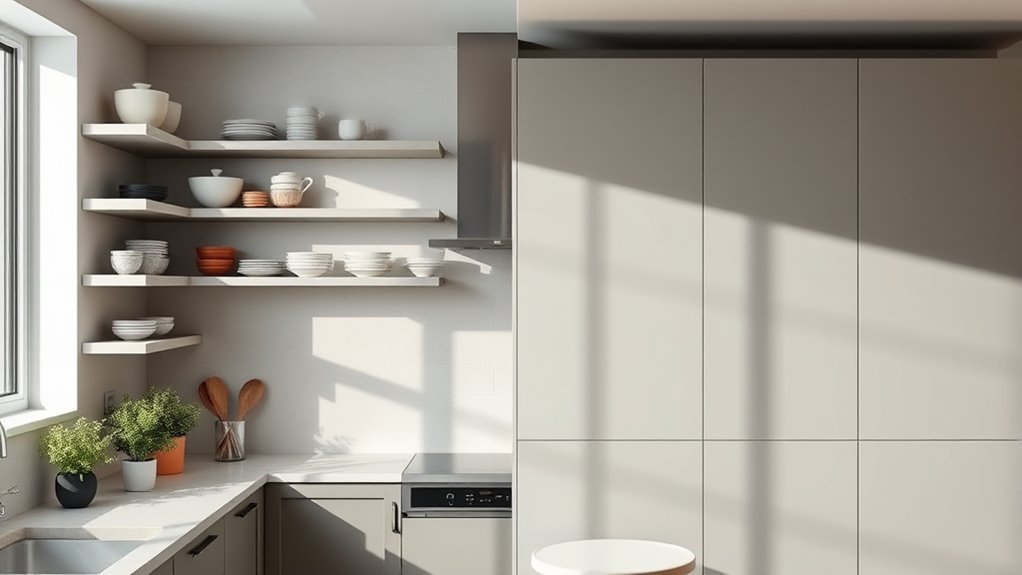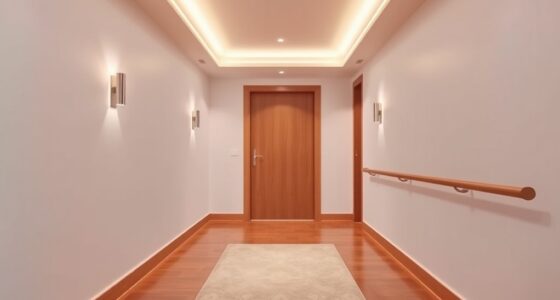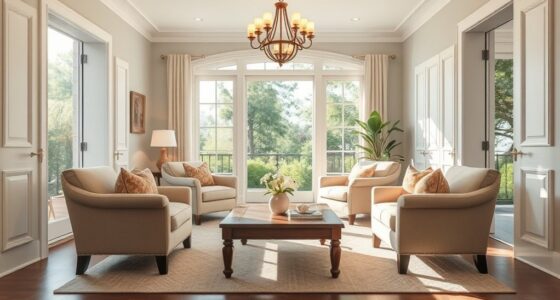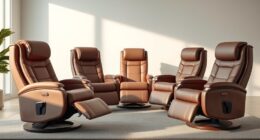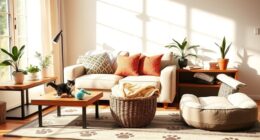If you want to reduce stress, closed cabinets might be better because they hide clutter and create a tidy look, promoting calmness. Open shelves can make your space feel more inviting and personalized, but if not kept organized, they may increase visual clutter and anxiety. Finding the right balance depends on whether you prefer easy access and display or a neat, distraction-free environment. Keep exploring to learn how each option could best suit your space and mood.
Key Takeaways
- Closed cabinets hide clutter, creating a tidy space that promotes relaxation and minimizes visual stress.
- Open shelving allows for organization and neat displays, reducing stress when kept well-maintained.
- Concealed storage prevents visual overload, supporting calmness and emotional well-being.
- Open shelves may increase stress if cluttered, while closed cabinets offer a distraction-free environment.
- The choice depends on balancing easy access and display with the need for a calm, uncluttered space.
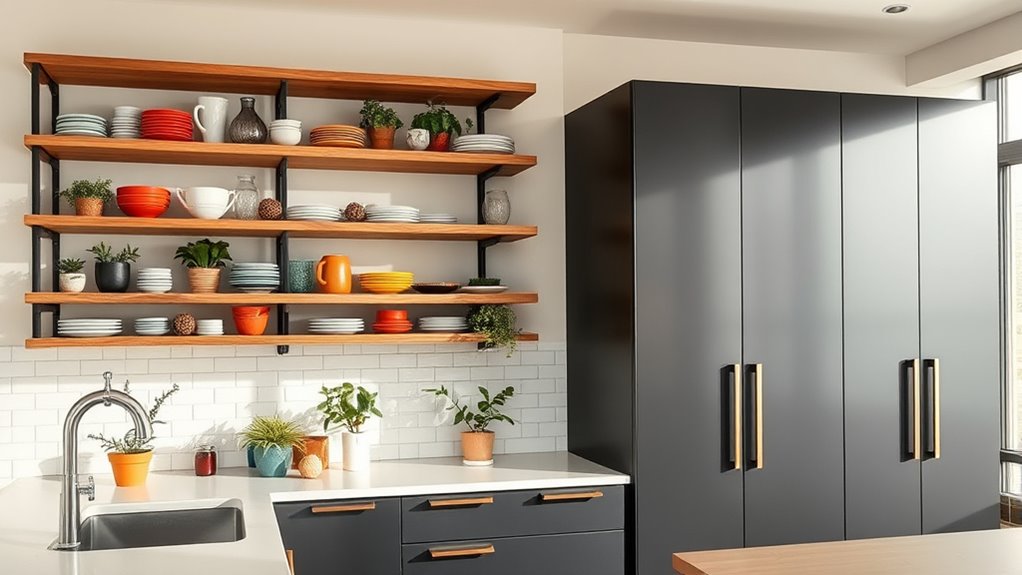
When choosing between open shelving and closed cabinets for your space, understanding their differences can help you make the best decision. Both options serve practical purposes, but they also influence the atmosphere of your home, especially regarding stress levels. Open shelving creates a sense of openness and accessibility. When you see your items displayed openly, it can make your space feel more inviting and less cluttered, as long as you keep things organized. You don’t have to open doors or dig through drawers to find what you need, which can reduce frustration and save time. However, open shelves demand regular tidying because clutter quickly accumulates, and a messy shelf can increase anxiety rather than decrease it. If you’re someone who thrives on order and cleanliness, open shelving might help you maintain a calming environment—when kept well-organized.
On the other hand, closed cabinets hide your belongings, which can lead to a less chaotic appearance. This concealment often results in a more streamlined look, making your space appear tidy even if it’s not perfectly arranged. For many, this sense of order is calming; it prevents visual clutter from overwhelming the room and can reduce feelings of stress. If you’re prone to feeling overwhelmed by mess, closed cabinets offer a sanctuary where you can stow away items out of sight. The downside is that retrieving things requires opening doors and possibly rummaging through cluttered drawers, which can sometimes cause frustration, especially if you’re in a hurry or dealing with limited space. Additionally, closed cabinets can make a room feel smaller or more confined if they’re bulky or heavy-looking, potentially adding to a sense of claustrophobia. Incorporating organized storage solutions can help mitigate this issue and maintain a sense of spaciousness.
Your choice also depends on your habits and preferences. If you enjoy displaying your favorite pieces or like to change decor frequently, open shelving offers flexibility and visual interest that can lift your mood. Conversely, if you value privacy or want a minimal look, closed cabinets help create a peaceful, distraction-free environment. The level of maintenance you’re willing to commit to plays a role too. Open shelves require ongoing organizing, which might be stressful if you’re busy or dislike cleaning. Closed cabinets demand less daily upkeep but require you to remember where everything is stored, which can be frustrating in its own way.
Ultimately, the decision comes down to what reduces your stress more: the visual calm of hidden storage or the airy openness of displayed items. Both have their merits, but understanding how each affects your daily routine and emotional well-being can guide you toward a choice that promotes a more peaceful, less stressful home environment.
Frequently Asked Questions
How Do Open Shelving and Closed Cabinets Impact Kitchen Cleanliness?
Open shelving makes it easier for you to see and access items quickly, so cleaning is more straightforward. However, it also shows dust and clutter, which means you need to clean more often to keep everything tidy. Closed cabinets hide messes, reducing visual stress, but require regular wiping inside. You should consider your cleaning habits and how often you’re willing to maintain either option to keep your kitchen spotless.
Which Storage Type Is More Cost-Effective Long-Term?
Choosing closed cabinets costs less long-term because they hide messes and require less maintenance. You won’t need frequent replacements or repairs, saving you money over time. Open shelving might seem cheaper upfront, but dusting, cleaning, and reorganizing can add up. You stay stress-free and savvy by selecting sturdy, sealed cabinets that keep clutter concealed, simplify cleaning, and save your budget in the long run.
Can Open Shelving Work in Small or Cluttered Spaces?
Yes, open shelving can work in small or cluttered spaces if you keep it organized. Use baskets, trays, or decorative storage to hide clutter and maintain a tidy look. Limit the number of open shelves to prevent visual clutter and regularly declutter to keep the space feeling open and inviting. With thoughtful organization, open shelving can make small areas feel more spacious and functional.
How Do These Options Influence Home Resale Value?
Imagine your home as a canvas; closed cabinets are like a neat, professional frame, boosting curb appeal and hiding clutter, which can attract buyers. Open shelving acts like bold brushstrokes, showcasing personality but risking disorder. Choosing the right balance appeals to a broader audience, enhancing resale value. You want a space that feels inviting and organized, so consider how each option reflects your home’s potential to future buyers.
Are There Specific Styles Better Suited for Open or Closed Storage?
You’ll find that modern, minimalist styles work best with open shelving, highlighting clean lines and simple designs. Traditional or classic looks often suit closed cabinets, providing a polished, timeless appearance. If you prefer a cozy, inviting feel, opt for closed cabinets with decorative details. For a sleek, contemporary vibe, choose open shelves with streamlined hardware. Ultimately, match your style to your storage preferences to create a harmonious, stress-reducing space.
Conclusion
Ultimately, choosing between open shelving and closed cabinets is like selecting a clear window or a tinted one—you control what’s visible and how you feel. Imagine walking into a cluttered kitchen versus a tidy one; the first might feel overwhelming, while the second invites calm. Studies show that organized spaces reduce stress. So, whether you prefer to showcase your favorites or hide the mess, remember, your choice shapes your daily peace—creating a space that feels just right.
